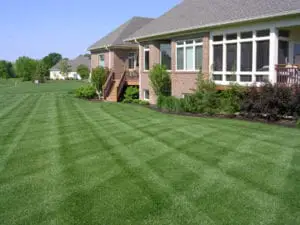
This is probably one of the most popular questions we get. And it's an easy question to ask, right? You see your neighbor's lawn every day. You see it when you mow and you see it as you drive by. Maybe it's greener. Maybe it's more lush. Maybe it has fewer weeds. And while it's an easy question to ask, it's a difficult question to answer. There are many factors that make a lawn what it is.
Grass cultivars. To many home owners, grass is grass. But that is not the case. There are several species of grass and within each species are up to dozens of cultivars, or varieties. Each cultivar has its unique characteristics, such as color, texture, disease resistance, etc. So, even though you and your neighbor both have Kentucky bluegrass, you may have a different cultivar.
Watering. Watering has a big impact on the health of the lawn. Especially when temperatures increase and rainfall decreases.A lawn typically needs 1 inch of water per week. When temperatures soar north of 90 degrees, it may need closer to 2 inches. Watering is more of a science than you may think and may require a little advance homework to get it right. Many residential "sprinklers" deliver water fairly slowly, so it may take an hour or more to deliver an inch of water. It's also better to water in one or two sessions than on a daily basis. Frequent watering creates shallow roots and shallow roots lead to an unhealthy lawn. So, water once or twice a week and water for as long as it takes to deliver 1 inch of water. Hint: place a pie pan or tuna can in the lawn as you water - when the water is an inch deep, you're done!
Shade. Shade impacts the overall health of a lawn too. Grass is a sun-loving plant and excessive shade can choke out a lawn. Ever wonder why your lawn thins out under that big maple tree in the front yard. Shade. There are grasses designed to grow in the shade, but even they need some level of sunlight. So if your lawn has many large trees and the grass seems to thin as the summer progresses, it may be the shade.
Aeration. Central Indiana lawns need aeration. The clay-rich soil creates very dense growing conditions for grass and aeration helps loosen up the soil to enable roots to grow deeper and stronger. Aeration is the process of removing nickel-sized plugs of soil from the lawn. The plugs will breakdown over several weeks. The holes in the soil allow water and nutrients to reach the roots.
Mowing height. Grass grows. And because it grows that means it has a natural disposition to be tall. It's what it is programmed to do. Therefore, when people mow their lawns short (less than 3 inches), they are essentially forcing grass to be something that it is not. The ideal height for grass is 3-4 inches. Taller grass means deeper roots. Deeper roots equals healthy grass. When you mow short, you create shallow roots, and that's bad. Short lawns will lose color and attract weeds. These are just a few things that can affect the quality of a lawn and may explain why your lawn looks different than your neighbors. There are other reasons of course, but these are the biggies. If you have any questions, just let us know.
